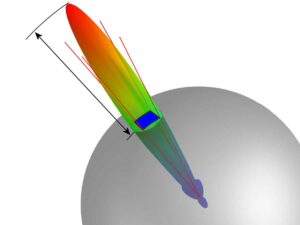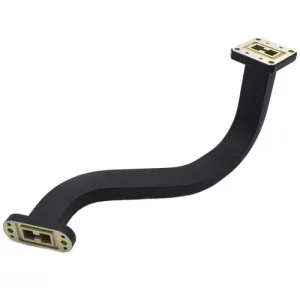Table of Contents
Physical shock
In a laboratory environment, waveguides often need to be disassembled, maintained, or calibrated. If it is not handled properly, such as dropping the waveguide to hard ground, it can cause dents and micro-cracks. The impact resistance of aluminum waveguides is generally able to withstand a pressure of 6,000 pounds per square inch, while the impact resistance of copper waveguides is up to 9,000 pounds per square inch. When the pressure applied exceeds these standards, irreversible damage to the waveguide will occur, resulting in an increased signal attenuation rate and a 20% to 50% reduction in signal strength.
The installation position of the waveguide also affects the risk of damage. If the height of the waveguide is set to 1.5 meters above the ground in the communications equipment room, the waveguide is installed on the support, and the surrounding protection measures are not enough, the operator is likely to cause impact when moving or moving the equipment. Nearly 40% of the waveguide damage cases are related to the improper installation position.
Maintenance and inspection of the waveguide can reduce the damage rate by about 30%, including the surface state of the waveguide, whether the connection point is loose, etc. These measures can detect potential problems in time, thereby reducing the chance of damage to the waveguide due to physical impact. If the waveguide is found to be slightly deformed during use, it should be repaired or replaced immediately to ensure the reliability of signal transmission.
About 70% of physical injuries are caused by improper operation, and regular training of employees to improve their knowledge of how to operate equipment can significantly reduce the risk of damage. Some companies emphasize in training not to place heavy objects on the waveguide, such a simple measure can effectively prevent the waveguide from being impacted, thus extending the service life of the equipment.

Thermal stress
When the waveguide is working, the transmission of the signal will generate heat. Microwave waveguides operate at frequencies between 1 GHz and 30 GHz, and at this frequency, the internal temperature of the waveguide rapidly rises to more than 150 degrees Celsius. If the waveguide material does not dissipate heat effectively, the internal heat accumulation will lead to thermal expansion, which in turn creates stress. If this stress exceeds the tolerance range of the material, it will lead to micro-cracks, which will affect the transmission quality of the signal, and signal attenuation of up to 30%.
Aluminum and copper are common waveguide materials, aluminum has a thermal conductivity of about 237 W/(m·K), while copper has a higher thermal conductivity of 400 W/(m·K). In some high-power applications, if low thermal conductivity materials are selected, the operating temperature of the waveguide increases by 10%-20%, which significantly increases the risk of waveguide damage.
In devices using active cooling systems, the average operating temperature of the waveguide can be reduced by 25%, thus reducing damage caused by thermal stress. In the absence of a cooling system, the average life of the waveguide is only 1 to 2 years, and under good cooling conditions, the service life can be extended to more than 5 years. Facilities with temperature monitoring reduced waveguide damage by about 40 percent.

Electric arc
The arc is formed because the electric field strength inside the waveguide is too high, exceeding the breakdown voltage of the air or material. In a typical communication waveguide system, the power is as high as hundreds of watts or even several kilowatts, and the electric field strength reaches more than 30 kV per centimeter. When the electric field strength exceeds the breakdown voltage of the air (about 30 kV per centimeter), an arc will be formed inside the waveguide, resulting in ablation or local damage on the waveguide surface, and the signal transmission efficiency will be reduced by about 20% to 50%.
If there is dust or water inside the waveguide, the chance of arc formation increases by about 40%. Some outdoor waveguides, especially those used for satellite communications, are often exposed to a humid environment, and a 10% increase in the moisture content of the waveguide will double the chance of arc damage.
One way to avoid arc formation is to use a vacuum or a waveguide structure filled with inert gas. The vacuum waveguide can avoid ionization in the air, which greatly reduces the probability of arc occurrence. In systems using vacuum waveguides, the arc damage rate is reduced by more than 80%, while the signal transmission efficiency is improved by about 15%. The waveguide filled with nitrogen and other inert gases can also play a similar effect, by avoiding air ionization, further reducing the occurrence of arc and extending the service life of the waveguide.
Small particles or oil on the surface of the waveguide can become the induction point of the arc, and the arc damage rate is reduced by about 60% under the condition of regular internal cleaning. Cleaning every 3 to 6 months can effectively reduce the pollutants inside the waveguide, extending the life of the waveguide from the original 3 years to 5 years, and reducing equipment maintenance costs by about 20%.
Corrosion
Waveguide materials are mostly metals, such as aluminum, copper or silver-plated copper, which are prone to oxidation reactions when exposed to moisture, salt and other corrosive chemicals in the air for a long time. In coastal areas, the air contains a lot of salt, in a high salt environment, the corrosion rate of aluminum waveguide may reach 0.01 to 0.03 mm per year, long-term use will lead to the gradual thinning of the waveguide wall, ultimately affecting its structural integrity and signal transmission performance.
Because the waveguide equipment installed in the coastal area does not adopt effective anti-corrosion measures, the surface of the waveguide appears obvious corrosion traces after 3 years of use, resulting in about 25% increase in signal transmission loss. Under the same conditions, the corrosion rate of the waveguide with anti-corrosion coating is greatly reduced, and the transmission efficiency is only reduced by less than 5%.
When the metal surface inside the waveguide is corroded, the electrical conductivity decreases and the impedance of the signal transmission increases. After the corrosion layer of 0.02 mm appears inside the aluminum waveguide, the efficiency of signal transmission is reduced by about 15%. Although copper waveguides have better corrosion resistance, the oxidation layer inside them can also cause signal loss to increase by 10% in high humidity environments.
The use of anti-corrosion coating can effectively cut off moisture and other corrosive substances in the air, the communication equipment of the oil platform, installed with high-performance anti-corrosion coating copper waveguide, after 5 years of use, the surface of the waveguide almost no signs of corrosion, maintenance costs reduced by 30%. Another effective anticorrosion method is to use stainless steel or alloy materials, which have much higher corrosion resistance than ordinary metals, although the price is higher, but its long service life can reduce the cost of replacement and maintenance in the long term.
Contaminate
If dust or other particles of 0.1 mm thickness accumulate inside the waveguide, the signal attenuation rate increases by up to 15%. After one year of operation of the waveguide system in the manufacturing plant, it was found that a large amount of metal dust and oil had accumulated inside the waveguide, and the signal transmission efficiency was reduced by about 20%. To solve this problem, the factory added an air filtration system and cleaned the waveguide internally once a quarter, reducing the waveguide signal loss rate to less than 5%.
Water in the air enters the interior through the joints or connection points of the waveguide, and the water will chemically react with the metal material of the waveguide, producing oxides or other corrosive products, which further aggravate the attenuation of signal transmission. A waveguide operating in an environment with more than 80% humidity increases its internal moisture content by 20%, resulting in a signal transmission loss of about 10%. When using waveguides in wet areas, regular drying and dehumidification are necessary.
If the connector area of the waveguide is contaminated, the stability of signal transmission will be seriously affected. In the communication system, due to oil and dust in the connector area, the volatility of signal transmission increased by about 30%. After cleaning and reconnecting, the signal transmission of the system was restored to stability and the failure rate was reduced by 50%.







